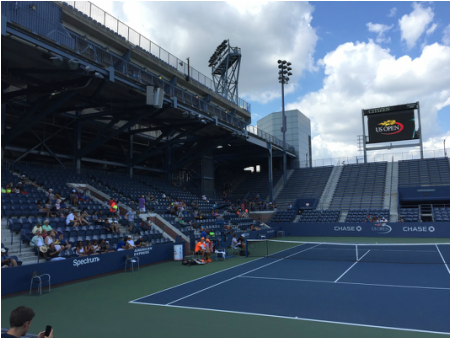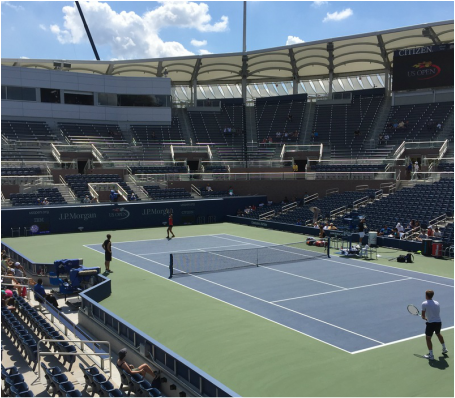 Once House of Horrors, Now Practice Court for John Isner; Next Year, Gone. Once House of Horrors, Now Practice Court for John Isner; Next Year, Gone. Strictly by coincidence, the Times has a feature on the Op-Ed Page Saturday about the vanishing storefronts of New York, victims of rising rents. I was already planning my ode to the vanishing landmark of Queens, the house of upsets, the cramped, smoky pit known as the Grandstand. Once upon a time it was the second court at the United States Open, an afterthought grafted onto the main arena, Louis Armstrong Stadium, itself a tennis improv. But now in the name of modernity, the Grandstand has been phased out. It is serving as Practice Court 6 for this year’s Open but then will be bulldozed, gone, like ancient temples destroyed by vandals. The Open is one of the two best sporting events in my home-town, along with the one-day phenomenon of the Marathon in the fall. I can look past the money and the privilege and see the Open, with its roots at the West Side Tennis Club in Forest Hills, as still very much a Queens event, right off the No. 7 elevated train. This year the Open has a new retractable roof over Ashe Stadium to keep the show moving when the monsoon hits. The Armstrong will be replaced by a new second stadium. The Open also has a new generic bowl, called the Grandstand with 8,200 seats. I am sure it has more amenities than the old Grandstand but it does not exactly have the feel of an Elizabethan bear-baiting den. For many years, the players had to inhale the meaty fumes from a restaurant suspended above the west stands. Something was always out to get the favorite at the Grandstand: In 1985, Kevin Curren, the fifth-seeded player from South Africa, was bumped off in the first round by upcoming young Guy Forget of France. Curren promptly emitted a Hope Solo solo, blaming the site for his troubles. “I hate the city, the environment and Flushing Meadow,” Curren said. “There is noise, the people in the grandstand are never seated and it takes an hour and a half in traffic to get here. It’s sickening that with all the money they get from TV, the USTA doesn’t build a better facility. The USTA should be shot. And they should drop an A-bomb on the place.” Curren was not the only player to get bushwhacked in the Grandstand. On Friday I ran into a former player who had benefited from the blood lust of the fans. In 1981, Andrea Leand, all of 17, met second-seeded Andrea Jaeger in the second round – in the Grandstand. “Andrea was up a set and 5-2,” Leand recalled. “I could hear a broadcaster saying, ‘That’s it, she’s done.’” Then again, you could hear everything in the Grandstand. “I heard a man asking his son, ‘Do you want a hot dog?’” The mob began howling for a new victim to be sacrificed to the Grandstand deities. “The sound went right through you,” Leand recalled with a beatific smile. She beat Jaeger, 1-6, 7-5, 6-3. It could happen to anybody, and often did. The litany of Grandstand upsets is long – best left to an expert like Randy Walker, who last year wrote a farewell to the Grandstand, well worth reading: The great thing about the ramshackle center of the 80’s was that reporters could watch Grandstand matches from the back of the press box in the main stadium. One match turned into a heavyweight fight -- Roscoe Tanner, one of the hardest hitters on the tour, and Chip Hooper, a big fellow, trying to drill each other, up close and apparently quite personal. This being the yappy borough of Queens -- Trump! McEnroe! Archie Bunker! -- the fans egged them on. Competition was also nasty in the lines as fans tried to get into a match that had suddenly turned epic. I visited the old den the other day – a few fans watching John Isner and a hitting partner whacking the ball around, but no yelps from fans seeking a new victim. The Grandstand could have served forever as an anarchic, irregular heirloom – a tribute to history. But Open executives can still revive the gritty aura of the old place: pipe fumes from the grille directly onto the court. Kevin Curren would feel right at home.
Hansen Alexander
8/27/2016 01:21:26 pm
Ah, the George of my heart has returned, exhibiting the humor via overstatement, understatement, and bemusement that I love, that personal whacking of Roscoe Tanner and the other insanely hard servers of the US Open Court. Nothing like the over the top yelp of losers in a very personal game. Actually, it is comforting to know that not only is my Upper West Side neighborhood being deserted by higher rents but Queens as well. There is something comforting in knowing that decline is distributed equally, as Manhattan become Hong Kong and Queens the last outpost of the Middle Class. Or is the US open the last outpost of the Middle Class? LOL
George Vecsey
8/27/2016 02:09:00 pm
Hansen, thanks. I needed a week off to catch up on another project. 9/1/2016 11:21:38 am
Hansen—I can relate to your concern about the accelerating demise of the small neighborhood merchants on the Upper West Side, as well as the rest of the city.
Brian Savin
8/28/2016 08:55:23 pm
I saw a lot of great matches on the Armstrong Court over the years, forsaking seats in the big stadium for the more intimate setting and often greater competitiveness. However, I have always wished I had gone to Forrest Hills. Just missed. A kid in my freshman dorm, who's family belonged to the Club, was the head ball boy for the Open that year and was told to line up extra ball boys. I told him I'd do it. Last minute, he was told they had enough. Crap! Before long, the tournament moved to Flushing and everything changed, including dropping the name "Lawn" from the Association name.
George Vecsey
8/28/2016 10:32:00 pm
Brian,: it was so small in early 50's when my dad got me a press pass, first 9 days. Players signed autographs. Grass. Hedges. One tiny clubhouse. It is still the template for "my" Open. We saw BJ King first time, circa 1961, whacking herself on the leg with her racquet, berating herself on back court. My wife and I became instant fans for life. I always tell her that.
Roy Edelsack
8/30/2016 06:28:20 am
As I might have mentioned before, I have gone to at least one session at the US Championships/US Open since 1959. I went again yesterday and the new "Grandstand" is simply not a grandstand. It's an 8,000-seat stadium where, consistent with the philosophy of the USTA, the lower bowl is reserved seating. So much for intimacy.
George Vecsey
8/30/2016 09:01:22 am
Roy, great memories. I gather there was a belt of empty seats around the court, and lines to squeeze into the upper reaches. Sounds like the Olympics, with the empty official seats up close.
Joshua Rubin
9/1/2016 10:17:13 am
Hi, George, Comments are closed.
|
Categories
All
|










